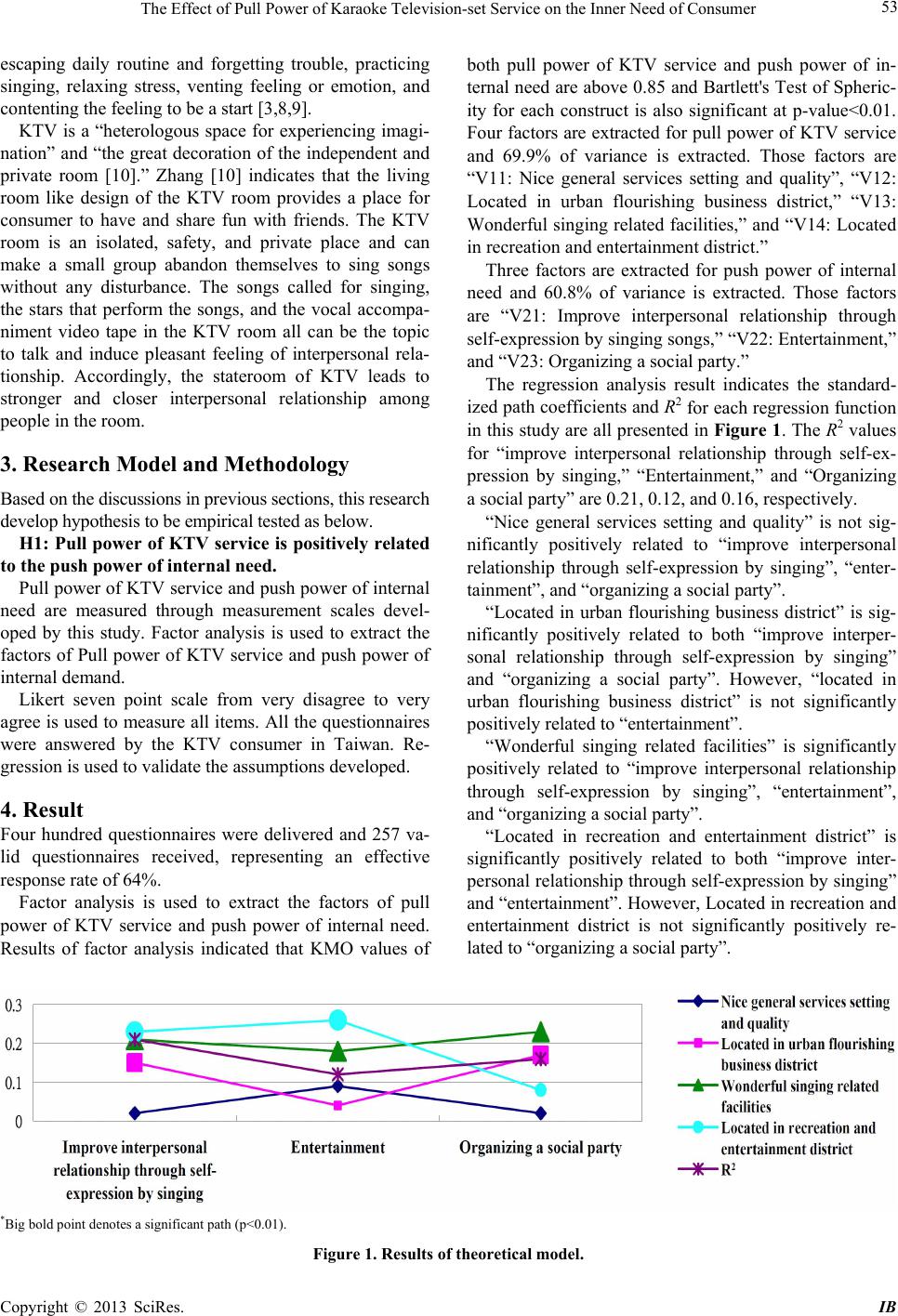
The Effect of Pull Power of Karaoke Television-set Service on the Inner Need of Consumer 53
escaping daily routine and forgetting trouble, practicing
singing, relaxing stress, venting feeling or emotion, and
contenting the feeling to be a start [3,8,9 ].
KTV is a “heterologous space for experiencing imagi-
nation” and “the great decoration of the independent and
private room [10].” Zhang [10] indicates that the living
room like design of the KTV room provides a place for
consumer to have and share fun with friends. The KTV
room is an isolated, safety, and private place and can
make a small group abandon themselves to sing songs
without any disturbance. The songs called for singing,
the stars that perform the songs, and the vocal accompa-
niment video tape in the KTV room all can be the topic
to talk and induce pleasant feeling of interpersonal rela-
tionship. Accordingly, the stateroom of KTV leads to
stronger and closer interpersonal relationship among
people in the roo m.
3. Research Model and Methodology
Based on the discussions in previous sections, t his research
develop hypothesis to be empiri cal tested as below.
H1: Pull power of KTV service is positively related
to the push power of internal need.
Pull power of KTV serv ice and push power of intern al
need are measured through measurement scales devel-
oped by this study. Factor analysis is used to extract the
factors of Pull power of KTV service and push power of
internal dem and.
Likert seven point scale from very disagree to very
agree is used to measure all items. All the questionnaires
were answered by the KTV consumer in Taiwan. Re-
gression is used to validate the assumptions developed.
4. Result
Four hundred questionnaires were delivered and 257 va-
lid questionnaires received, representing an effective
response rate of 64%.
Factor analysis is used to extract the factors of pull
power of KTV service and push power of internal need.
Results of factor analysis indicated that KMO values of
both pull power of KTV service and push power of in-
ternal need are above 0.85 and Bartlett's Test of Spheric-
ity for each construct is also significant at p-value<0.01.
Four factors are extracted for pull power of KTV service
and 69.9% of variance is extracted. Those factors are
“V11: Nice general services setting and quality”, “V12:
Located in urban flourishing business district,” “V13:
Wonderful singing related facilities,” and “V14: Located
in recreation and entertain men t district.”
Three factors are extracted for push power of internal
need and 60.8% of variance is extracted. Those factors
are “V21: Improve interpersonal relationship through
self-expression by singing songs,” “V22: Entertainment,”
and “V23: Organizing a social party.”
The regression analysis result indicates the standard-
ized path coefficients and R2 for each regression function
in this study are all presented in Figure 1. The R2 values
for “improve interpersonal relationship through self-ex-
pression by singing,” “Entertainment,” and “Organizing
a social party” are 0.21, 0.12, and 0.16, resp ectively.
“Nice general services setting and quality” is not sig-
nificantly positively related to “improve interpersonal
relationship through self-expression by singing”, “enter-
tainment”, and “organizing a social party”.
“Located in urban flourishing business district” is sig-
nificantly positively related to both “improve interper-
sonal relationship through self-expression by singing”
and “organizing a social party”. However, “located in
urban flourishing business district” is not significantly
positively related to “entertain ment”.
“Wonderful singing related facilities” is significantly
positively related to “improve interpersonal relationship
through self-expression by singing”, “entertainment”,
and “organizing a social party”.
“Located in recreation and entertainment district” is
significantly positively related to both “improve inter-
personal relationship through self-expression by singing”
and “entertainment”. However, Located in recreation and
entertainment district is not significantly positively re-
lated to “organizin g a social party”.
*Big bold point denotes a significant path (p<0.01).
Figure 1. Results of theoretical model.
Copyright © 2013 SciRes. IB